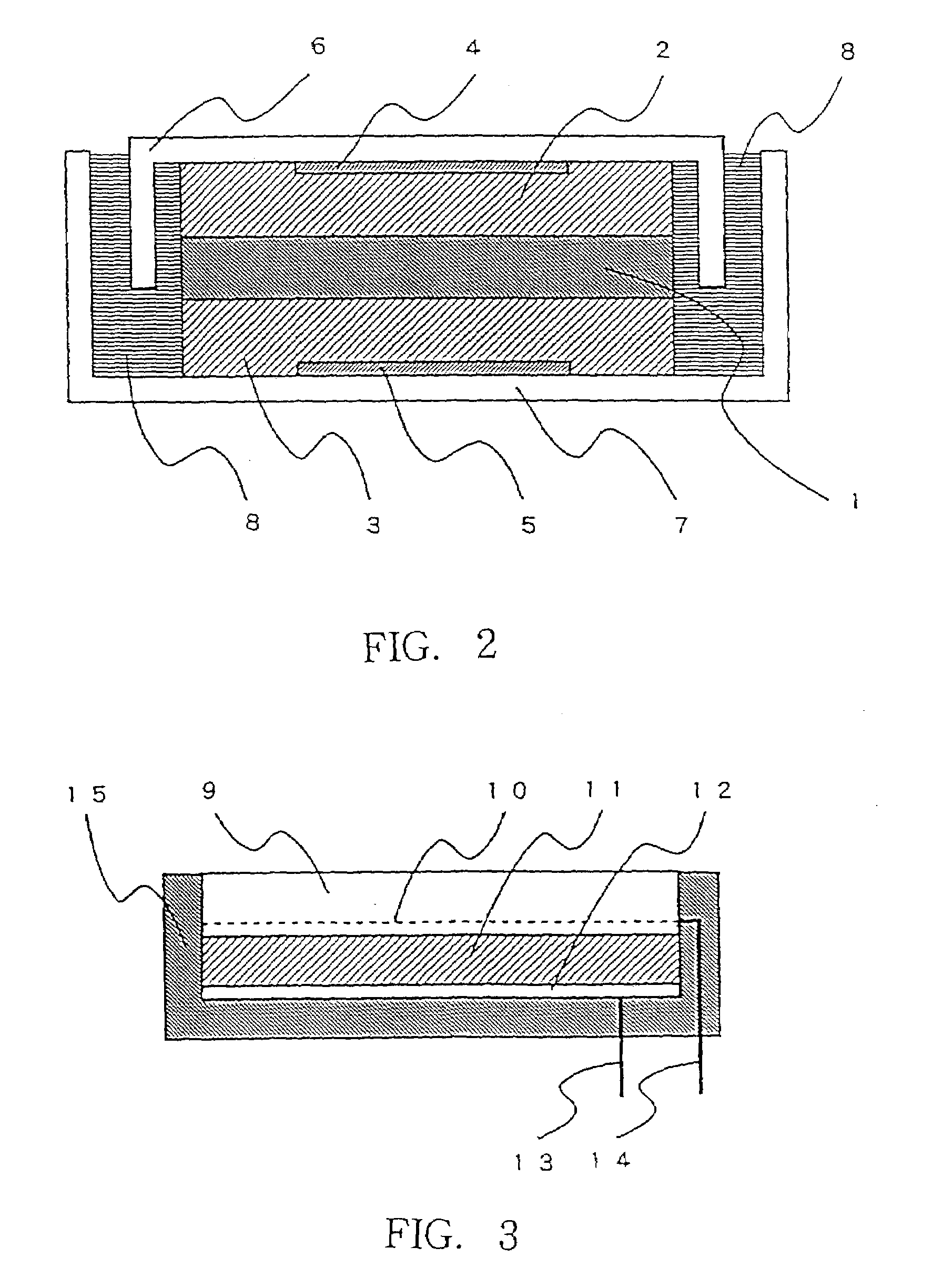Alkali ion conductive glass-ceramics and electric cells and gas sensors using the same
a technology electric cells, applied in the field of alkali ion conductive glassceramics and electric cells and gas sensors using the same, can solve problems such as conductivity drop, and achieve the effect of high performan
- Summary
- Abstract
- Description
- Claims
- Application Information
AI Technical Summary
Benefits of technology
Problems solved by technology
Method used
Image
Examples
example 1
[0072]As starting materials, NH4H2PO4, TiO2, Al(OH)3 and Li2CO3 were used. These starting materials were weighed to constitute a composition of 39P2O5-8.5Al2O3-39TiO2-13.5Li2O in mol %. The materials were mixed uniformly and then put in a platinum crucible and heated and melted in an electric furnace. First, CO2, NH3 and H2O coming from the raw materials were evaporated at 700° C. Then the temperature was raised to 1450° C. and the materials were melted by heating them at this temperature for 1.5 hour. Thereafter, the melt was cast onto a stainless steel plate to form a uniform sheet glass. The glass was annealed at 550° C. for two hours for removing thermal stress of the glass.
[0073]The glass thus produced was cut into specimens each having the size of 20×20 mm. The specimens of glass were polished on both surfaces and subjected to heat treatment under various heat conditions. The crystal phase which precipitated in the specimens was determined by the powder X-ray diffraction metho...
example 2
[0074]As the starting materials, NH4H2PO4, TiO2, Al(OH)3, Ga2O3 and Li2CO3 were used to produce a glass-ceramic by employing the same manner as in Example 1. The crystal phase which grew in specimens of this glass-ceramic was determined to be Li1+X(Al, Ga)XTi2−X(PO4)3. The specimen which was heat treated at 950° C. for 12 hours exhibited the highest conductivity of 1.0×10−3S / cm (Table 1, Example No.2).
[0075]
TABLE 1(composition in mol %)ExamplesNo.12P2O53939TiO23938Al2O38.56.5Ga2O32.5Li2O13.514coductivity at room1.3 ×1.0 ×temperature (S / cm)10−310−3temperature of1000950heat treatment (° C.)time of1212heat treatment (Hr)
example 3
[0076]As starting materials, NH4H2PO4, SiO2, TiO2, Al(OH)3 and Li2CO3 were used. These starting materials were weighed to constitute a composition of 32P2O5-8SiO2-41TiO2-5Al2O3-14Li2O in mol %. The materials were mixed uniformly and then put in a platinum crucible and heated and melted in an electrical furnace. First, CO2, NH3 and H2O coming from the raw materials were evaporated at 700° C. Then the temperature was raised to 1450° C. and the materials were melted by heating them at this temperature for 1.5 hour. Thereafter, the melt was cast onto a stainless steel plate to form a uniform sheet glass. The glass was annealed at 550° C. for two hours for removing thermal stress of the glass.
[0077]The glass thus produced was cut into specimens each having the size of 20×20 mm. The specimens of glass were polished on both surfaces and subjected to heat treatment at a temperature of 800° C. for 12 hours and then at 1000° C. for 24 hours to produce a dense glass-ceramic. The crystal phase ...
PUM
| Property | Measurement | Unit |
|---|---|---|
| conductivity | aaaaa | aaaaa |
| decomposition voltage | aaaaa | aaaaa |
| conductivity | aaaaa | aaaaa |
Abstract
Description
Claims
Application Information
 Login to View More
Login to View More - R&D
- Intellectual Property
- Life Sciences
- Materials
- Tech Scout
- Unparalleled Data Quality
- Higher Quality Content
- 60% Fewer Hallucinations
Browse by: Latest US Patents, China's latest patents, Technical Efficacy Thesaurus, Application Domain, Technology Topic, Popular Technical Reports.
© 2025 PatSnap. All rights reserved.Legal|Privacy policy|Modern Slavery Act Transparency Statement|Sitemap|About US| Contact US: help@patsnap.com



